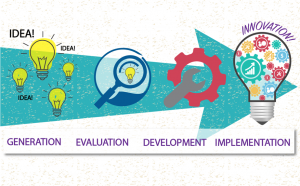
‘Innovation is the key to success!’ ‘Think Innovative!’ ‘Be Innovative!’
These are some of the few choice phrases the Manager tells his team. Immediately, everyone cramps up, quickly looks down and pretends to scribble in his or her notebook. Even the ones who were naturally expressive, kept mum.
The Manager is stumped. Isn’t there anyone in his team who can come up with an innovative idea to help the company?
Perhaps the problem in this scenario is the keyword ‘any one’. It’s not impossible, but more often than not, the expectations are just too high for just one person to come up with the solution that can turn the company around. Even if any idea was drummed up, it would be raw, unrefined, and thus may not be the ‘innovation’ you are looking for. ‘Idea’ and ‘innovation’ are seemingly similar words but at different stages of a journey.
How do you then turn an idea into innovation? If you find yourself in a similar position as the scenario above, take a step back and reflect. Understand your team’s individual thinking and behavioral preferences and work this to your advantage by bringing great people together into intact teams. In such a team you may find people who have inclinations in thinking:
- Analytically: A preference in thinking with data
- Structurally: A preference for pragmatism and systems
- Socially: A preference to think of and for people
- Conceptually: A preference to think of the big picture
Furthermore, these same people will have various degrees of behavioural preferences:
- Expressiveness: From quiet to gregarious
- Assertiveness: From peacekeeping to driving
- Flexibility: From focused to change-welcoming
 If you have a team with individuals with at least one of each attribute, this is what we call a WEteam™: your power team. With each step of the innovation process, you will find your team come to life.
If you have a team with individuals with at least one of each attribute, this is what we call a WEteam™: your power team. With each step of the innovation process, you will find your team come to life.
Step 1: Idea Generation
In ideation, we find that the Social preference thinker may get his or her inspiration by hashing ideas out with other people in the team while those more attuned to analytical ways of thinking could contemplate over existing practices, and use that data to formulate a better way of doing things. The Structural preference thinker may prefer to go through a proper process of ideation while the ones that enjoy conceptual thinking gets his inspiration from the world he sees around him.
Wherever the idea comes from, that is your first step. Almost immediately, you will have various ideas on the table.
Step 2: Evaluation
With so many ideas on the table, which one will work best for your organisation? The analytical preference thinker will naturally be at his or her best in this segment of the innovation process. He or she will sift out the best ideas from the lot by analyzing every idea for its merits and demerits. The best part about this? He or she enjoys doing so and will excel in it.
Step 3: Development
With ideas narrowed down to just a few, it’s time to develop them. Each team member will be able to contribute positively to it, and check it across their objectives. The social preference thinker will ask, “How is this solution going to benefit the people?” The conceptual preference thinker will question, “Great, but how does this fit into the overall big picture?” The idea becomes fuller, richer and with multiple facets.
Step 4: Implementation
An idea is just an idea, and it can be shelved for a very long time unless someone does something about it. This is where the structural preference thinker is able to ensure a process is in place, to see the idea to the finish line.
What is the result? You get an innovation for your company: an idea that solves an existing or future problem, and it works. Bonus: your team enjoys the process.
In the process, it is also important to bear in mind your team’s behavioral tendencies. If many in your team are on the more introspective side of the spectrum, opt for other ways to draw their ideas out. Instead of Brain-Storming, try Brain-Writing!
The WEapproach™ has helped numerous companies be more productive and innovative. The first step lies in understanding who your team members are as a manager.
A good friend and mentor of mine, once said to me: “As a manager, my KPI (key performance indicator) is not to be able to make ideas, but the ability to guide my people to perform well in their jobs, ensure they enjoy what they do, and develop a great team which can meet the goals of the company. If my people succeed, I succeed.”
———————————
Emergenetics is a research-based tool grounded in neuroscience theories that measures both thinking and behavioral preferences. The awareness and knowledge of the people who make up your company is a great start to harnessing their strengths for better good.
 Print This Post
Print This Post
